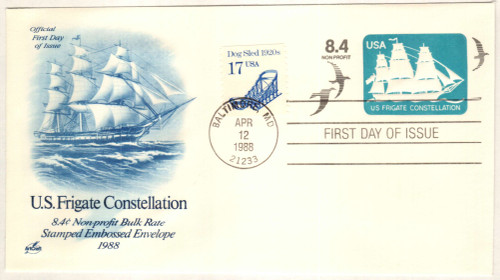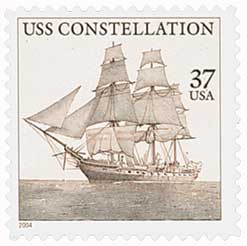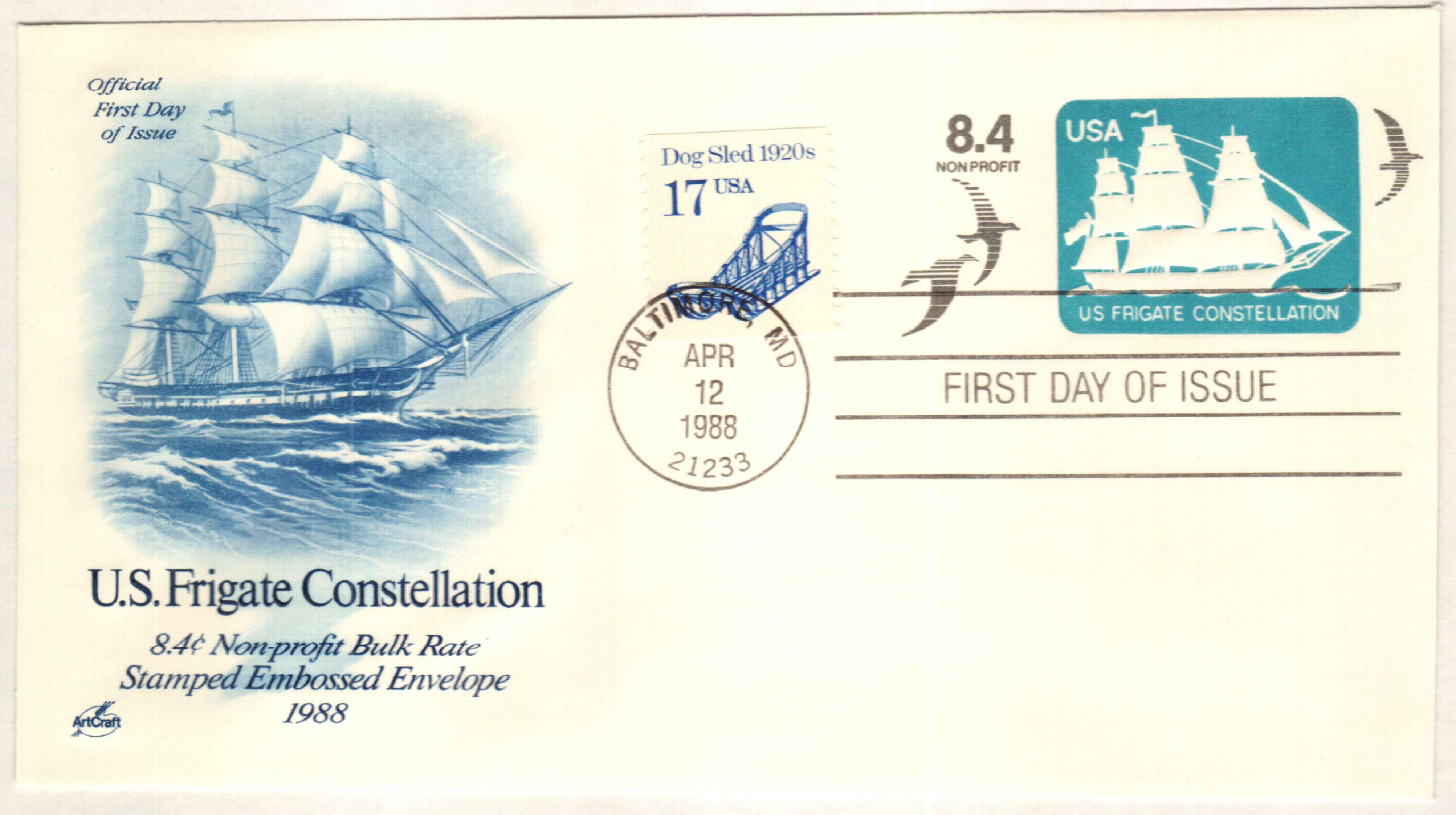
# U612 FDC - 1988 8.4c Stamped Envelopes and Wrappers - US Frigate Constellation
Â
Â
First USS Constellation LaunchedÂ

Ordered by a Congressional Act in 1794, the first American ship to be christened the Constellation was launched on September 7, 1797.
Designed by naval constructors Joshua Humphreys and Josiah Fox, the Constellation was the first ship commissioned into the United States Navy and the first put to sea. As such, it received the most esteemed name – Constellation, in honor of the ring of white stars against a blue background that was once featured on the American flag.
The Constellation was quickly pressed into service the following year, convoying merchantmen before traveling to the West Indies to protect American commerce in the Quasi War against France. The ship first saw battle on February 9, 1799 in the waters near Nevis. There it captured France’s fastest ship – the L’Insurgente – making it the first U.S. boat to capture an enemy vessel. Over the next few months, the Constellation seized two more French privateers. Amazed by its ability to travel 13 knots while sailing under nearly an acre of canvas sails, French sailors nicknamed it the “Yankee Racehorse.â€

The Constellation later traveled to the Mediterranean, participating in the blockade of Tripoli, evacuating Marines and diplomats, and joining in the battle that led to peace in 1805. During the War of 1812, the Constellation was blockaded by the British fleet, but it helped protect the forfications at Craney Island. After that war, the Constellation returned to the Mediterranean to once again battle the Barbary powers and helped capture the Algerian frigate Mashuda.
Aside from brief periods of repairs, the next several decades were busy for the Constellation. It protected American shipping operations in South America and the Mediterranean and helped end pirate and slave operations in the West Indies. The Constellation landed shore parties and provided boats for the Seminole uprising. In the early 1840s, it safeguarded American interests during the Opium War and protected Hawaii from becoming a British protectorate. The Constellation was essentially retired in 1845, remaining in the naval yard until it was dismantled in 1853. But many of its salvageable materials were used to construct a ship of the same name.
That ship, U.S. sloop of war Constellation, was launched in 1854 and sent to disrupt the slave trade off the coast of Africa. At the outbreak of the Civil War, it made the first Union Navy capture. Later, more than 60,000 World War I recruits trained aboard the Constellation.
Â
Â
Â
First USS Constellation LaunchedÂ

Ordered by a Congressional Act in 1794, the first American ship to be christened the Constellation was launched on September 7, 1797.
Designed by naval constructors Joshua Humphreys and Josiah Fox, the Constellation was the first ship commissioned into the United States Navy and the first put to sea. As such, it received the most esteemed name – Constellation, in honor of the ring of white stars against a blue background that was once featured on the American flag.
The Constellation was quickly pressed into service the following year, convoying merchantmen before traveling to the West Indies to protect American commerce in the Quasi War against France. The ship first saw battle on February 9, 1799 in the waters near Nevis. There it captured France’s fastest ship – the L’Insurgente – making it the first U.S. boat to capture an enemy vessel. Over the next few months, the Constellation seized two more French privateers. Amazed by its ability to travel 13 knots while sailing under nearly an acre of canvas sails, French sailors nicknamed it the “Yankee Racehorse.â€

The Constellation later traveled to the Mediterranean, participating in the blockade of Tripoli, evacuating Marines and diplomats, and joining in the battle that led to peace in 1805. During the War of 1812, the Constellation was blockaded by the British fleet, but it helped protect the forfications at Craney Island. After that war, the Constellation returned to the Mediterranean to once again battle the Barbary powers and helped capture the Algerian frigate Mashuda.
Aside from brief periods of repairs, the next several decades were busy for the Constellation. It protected American shipping operations in South America and the Mediterranean and helped end pirate and slave operations in the West Indies. The Constellation landed shore parties and provided boats for the Seminole uprising. In the early 1840s, it safeguarded American interests during the Opium War and protected Hawaii from becoming a British protectorate. The Constellation was essentially retired in 1845, remaining in the naval yard until it was dismantled in 1853. But many of its salvageable materials were used to construct a ship of the same name.
That ship, U.S. sloop of war Constellation, was launched in 1854 and sent to disrupt the slave trade off the coast of Africa. At the outbreak of the Civil War, it made the first Union Navy capture. Later, more than 60,000 World War I recruits trained aboard the Constellation.
Â












